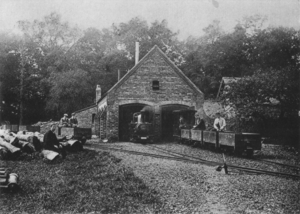Eaton Hall Railway

The Belgrave engine shed on the Eaton Hall Railway c.1898.
|
|
| Locale | England |
|---|---|
| Dates of operation | 1896–1946 |
| Track gauge | 15 in (381 mm) |
| Length | 4.5 miles (7.2 km) |
| Headquarters | Eaton Hall |
The Eaton Hall Railway was an early 15 in (381 mm) gauge minimum gauge estate railway built in 1896 at Eaton Hall in Cheshire.
It was built for the Duke of Westminster by Sir Arthur Percival Heywood, who had pioneered the 15 in (381 mm) gauge with his Duffield Bank Railway, and connected the hall to the GWR station sidings at Balderton on their Shrewsbury to Chester Line, some 3 miles (4.8 km) away.
The total length of the line was four and a half miles (7.2 km), with the addition of several branches including one long one to the brick store and estate workshop at Cuckoo's Nest.
The track was steel flat-bottomed rail of 16.5 pounds per yard (8.2 kg/m), attached by spring clips to cast iron sleepers, 3 feet (0.91 m) long and 6.5 inches (165 mm) wide, spaced at 2-foot-3-inch (0.69 m) centres. Pointwork was prepared at the workshop in Duffield (for which Heywood charged £7/15s/0d each (equivalent to £809 in 2015)), and carried to site. The maximum gradient was 1 in 70 (1.43%), Eaton Hall being 51 feet (16 m) above the sidings at Balderton.
For much of its length it followed the main driveway and crossed the park, including the major driveways. Therefore, the line had to be as unobtrusive as possible and was laid level with the ground with a central drainage pipe beneath. The ballast was red furnace cinder, 5 to 6 inches (127 to 152 mm) deep and 4 feet (121.92 cm) wide. On leaving the park the line was embanked. The line was not fenced - where it crossed between fields it was carried on girders over a deep ditch to prevent cattle straying.
...
Wikipedia
